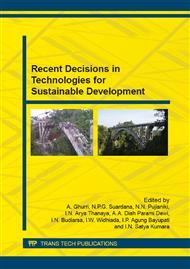p.3
p.9
p.17
p.24
p.30
p.36
p.41
p.47
Sustainable Development of Concrete Using GGBS: Effect of Curing Temperatures on the Strength Development of Concrete
Abstract:
The World Earth Summits in Rio de Janeiro, Brazil and Kyoto, Japan in 1992 and 1997 respectively, have made it clear that uncontrolled increased emission of greenhouse gases to the atmosphere is no longer environmentally and socially acceptable for sustainable development. The increase of cement production will affect the environmental preservation, natural conservation and increase the CO2 emission, which is one of the primarily gases that contribute to the global warming. The use of ground granulated blast furnace slag (ggbs) to replace a part of Portland cement in concrete can reduce the CO2 emission. It also can provide significant benefits to concrete properties, such as increase the workability and durability of concrete. The early strength of ggbs concretes that had been cured at standard curing temperature (20°C) were slower than that of concretes with Portland cement only, cured at the same temperature. However, there are some indications show that curing the ggbs concrete at elevated temperatures will significantly enhanced the early age strength of the concrete. The objectives of this research are to find out the effect of curing temperatures and levels replacement of Portland cement by ggbs on the strength development of concretes. The levels of ggbs to replace Portland cement were 0, 20, 35, 50 and 70%, while the curing temperatures were 20°C, 50°C and adiabatic curing. The concrete cubes were tested at ages: 6 and 12 hours, 1, 2, 4, 8, 16, 32, 64, 128, 256 and 365 days. The results showed that curing the ggbs concrete at temperatures higher than standard curing temperature, increased the strength development of the concrete at early ages.
Info:
Periodical:
Pages:
3-8
Citation:
Online since:
July 2015
Authors:
Keywords:
Price:
Сopyright:
© 2015 Trans Tech Publications Ltd. All Rights Reserved
Share:
Citation:


